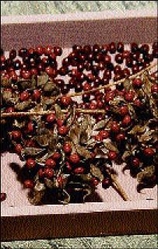

Ian Allen/Staff Photographer
LEFT:John Crow beads never looked so good: this set also sells for $700 and is hand-made from the Colombian Global Discovery trade show.
RIGHT: John Crow Beads
John Rashford, Contributor
The word 'John' appears 33 times in the Dictionary of Jamaican English as a generic term in the compound common names of people, birds, plants and other objects. This paper will show that objects named 'John' are often associated in Jamaica with the world of spirits.
I will focus on the vine Abrus precatorious, which Jamaicans call John Crow Bead, and it links - by virtue of John as a generic term - to the Christmas dancing in Jamaica called John Canoe ( also spelled Jonkonnu) and to the vulture called John Crow (Cathartes aura). This paper suggests that the dance, the bird and the plant all have the name John because of their relationship to the world of spirits and spirit possession.
Practice of obeah
It shows that John Canoe, who is the chief dancer of a troupe of dancers, is the spirit person or obeahman (variously described as a witch doctor, magician, jumbie-man or sorcerer) and both the John Crow and the John Crow Bead are associated with death and with materials used in the practice of obeah.
The John Crow Bead is a relatively small, woody, twining vine common throughout Jamaica in thickets, hedgerows, and along roadsides. It is often found climbing on fences, shrubs and the trunks and branches of small trees. Generally regarded as a vine of the Old world tropics, and usually thought native to India, John Crow Bead is now widespread throughout the tropical and subtropical regions of the world.
The most striking feature of this vine is its showy clusters of pea-shaped fruits that open when ripe to expose hard, smooth, glossy red and black seeds with the black covering about a third of each seed. Because of their beauty, these brightly coloured seeds have been used in Jamaica and throughout the tropics and subtropics to make amulets and charms as well as necklaces, bracelets, earrings and other personal ornaments. Many of the most widely known common names for Abrus precatorious are related to its attractive oval-shaped seeds.
John Crow Bead
The English common names for Abrus precatorious are Crab Eye, Liquorice (Licorice Vine, Indian Liquorice, Wild Liquorice or False Liquorice), Rosary Pea Vine or simply Rosary Pea, Jequirity (Jequirity Bean or Jequirity Pea), Precatory Bean and Prayer Bead. It is also called Luck Bean (especially in relation to Africa), Love Pea, Weather Plant or Weather Vine and Coral-Bead Plant. In the 18th century, Browne (1756) and Long (1774) in their discussions of Jamaica's plant life identified Abrus precatorious as Wild Licorice and Red Bean Vine; they made no mention of the name John Crow Bead. Today it is primarily known as Crab Eye and John Crow Bead (or John Crow Bead Vine or John Crow Eye).
In the Caribbean, the common names for Abrus precatorious point to its association with the spirit world and suggests that John as one of the generic terms in its compound common names is an expression of this association. The link is made by the fact that in Jamaica and elsewhere in the Caribbean, the plant is known as Jumbie Bead, and in some places, as, for example, the Virgin Islands, it is also called Devil Bead (Williams (jumbi, jumby, jumbee, jumbay, jamby) or zombie are just different terms for spirits. These terms are more widely used in the eastern Caribbean than in Jamaica (Cassidy 1971, Beckwith 1929).
In Jamaica, spirits are most frequently identified as 'duppies'. They are largely of human origin, being spirits of the dead. Usually considered more harmful than good, they interact with the living and in dong so directly affect the routine of daily life. They love the night, especially when perfumed by the aromatic basil (Ocimum basilicum L.) and the strong sweet smell of the night blooming jasmine (Cestrum nocturnum). They "feed upon bamboo root, 'fig' leaves and the gourd-like fruit of a vine called 'duppy pumpkin'" (Beckwith 1929 p 89) and live at the root of cotton trees (Ceiba pentandra), in burial grounds and old abandoned buildings, and in dark places such as caves, mangrove swamps, bamboo thickets and forests.
Extract from the article: Plants, Spirits and the Meaning of 'John' in Jamaica by John Rashford. The conclusion of this and other interesting perspectives can be found in Jamaica Journal Vol. 17 No. 2 An extensive collection of other Jamaica Journal back issues are also available.
All correspondence and subscription requests should be addressed to: The Institute of Jamaica, 10-16 East Street, Kingston. Telephone: (876)922-0620-6 Fax: (876)922-1147 Email: pr.ioj@mail.infochan.com website: www.instituteofjamaica.org.jm